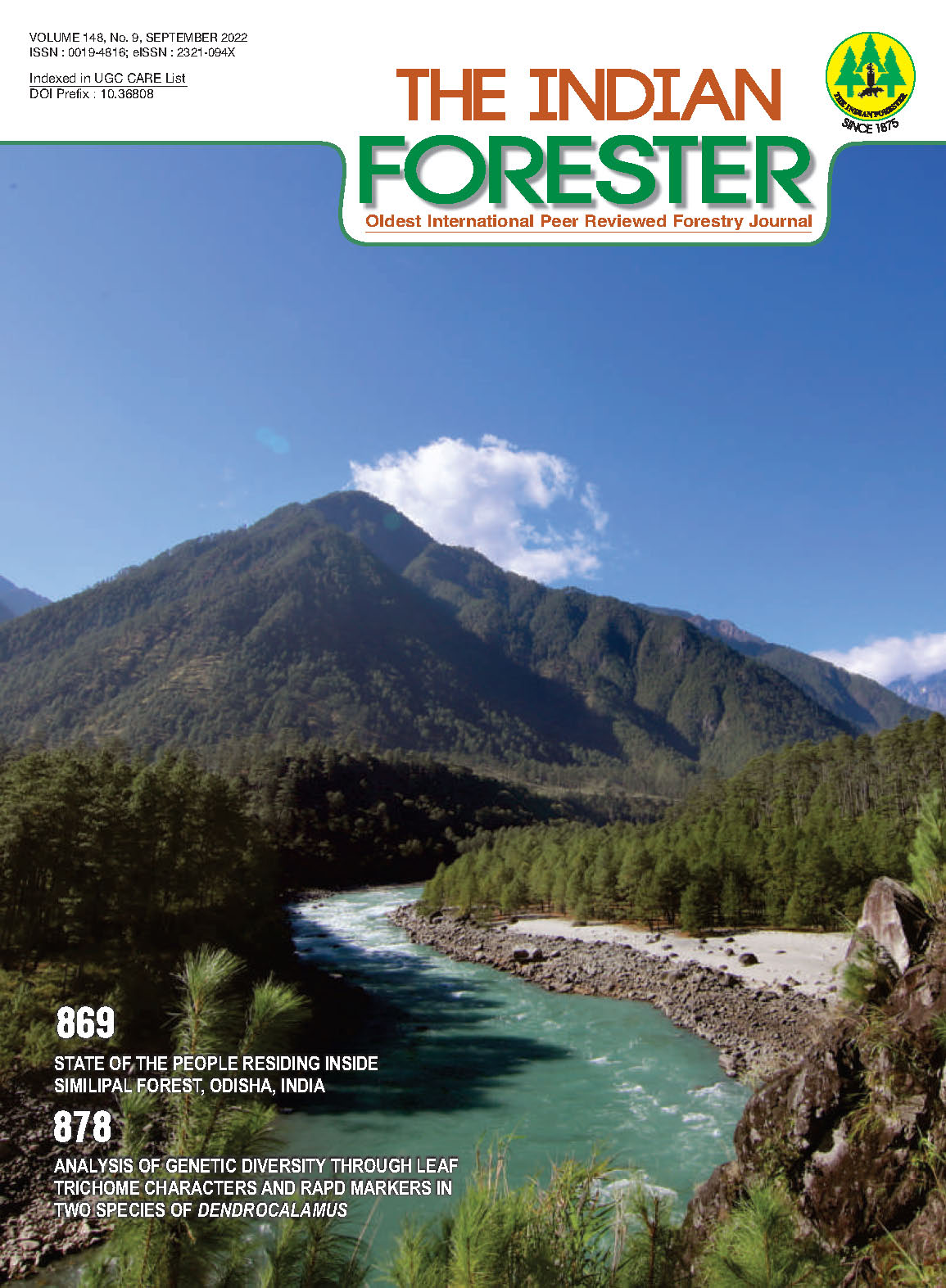State of the people Residing inside Similipal Forest, Odisha, India
DOI:
https://doi.org/10.36808/if/2022/v148i9/166688Keywords:
Similipal, Biosphere and tiger reserve, NTFP, Core area villages, Socio-economic condition, Village relocation, Implementation of Forest Right ActAbstract
Similipal forest is situated in Mayurbhanj district of Odisha, India. It is both atiger reserve and a biosphere reserve notified in 1973 and 1994 respectively
by Government of India. The tribes residing in the district of Mayurbhanj are
Bathudi, Bhumija, Kharia, Kolha, Mankidia, Munda, Santal, Bindhani and
others. There are 62 villages inside Similipal (four in the core and 58 in the
buffer zone of the reserve) and about 1200 villages located in the transitional
zone. The people in and around Similipal lead a subsistence living. The study
reveals that there is extreme poverty, unavailability of schools and
remoteness of tribal habitations in the core area. But there is an increase in
per capita income and a decent living for the families of relocated community.
Simultaneously, wild animals found extensive inviolate area for movement
and reproduction in the core area of Similipal reserve from where human
habitation is relocated.
References
Agrawal A. and Redford K. (2009). Conservation and displacement: An overview, Conserv Soc., 71: 1-10.
Barik B. (2003). Tribal population and settlement inside Similipal Biosphere Reserve: Their impact and management.
Dissertation submitted in partial fulfillment for the award of Master of Philosophy in Geography, Post Graduate Department of Geography, Utkal University, Bhubaneswar, Odisha, pp. 26.
Brockington D. and Igoe J. (2006). Eviction for conservation. A global overview. Conserv Soc., 43: 424-470.
Colchester M. (2004).Conservation policy and indigenous peoples.Cult. Surviv Q., 28: 17-22.
Dash J. (1998). Human ecology of foragers (A study of the Kharia (Savara), Ujia (Savara) and Berhor in Similipal hills). Commonwealth, New Delhi, pp.483+xx.
Das R.N. and Das N. (1968). Living conditions of tribals of Similipal hills. Adivasi (special issue), 10(2): 1-69.
Ferraro P.J. (2008). Protected areas and human well-being economics and conservation in the tropics: A strategic dialogue. RFP Conference Paper, Jan 31.
Lasgorceix A. and Kothari A. (2009). Displacement and relocation of protected areas: A synthesis and analysis of case studies. EPW, 49: 37-49.
Mahapatra A.K., Tewari D.D. and Baboo B. (2015). Displacement, deprivation and development: The impact of relocation on income and livelihood of tribes in Similipal tiger and biosphere reserve, India. Environ Manage., 56(2): 420-32.
Panwar H.S. (2003). Historical overview of relocation issues in conservation. In Proceeding of National Seminar-cumConsultation on Relocation of People from Protected Areas in India: Policy and Process. Council for Social Development, New Delhi, September 18, 2003.
Rangarajan M. and Shahabuddin G. (2006). Displacement and relocation from protected areas: Towards a biological and historical synthesis. Conserv Soc., 43: 359-378.
Sagar V., Kaelin C.B., Natesh M., Reddy A., Mohapatra R.K., Chhattani H., Biswas S., Bhatt S., Paul S., Jhala Y.V., Verma M.M., Pandav B., Mondol S., Barsh G.S., Swain D. and Ramakrishnan U. (2021). High frequency of an otherwise rare phenotype in a small and isolated tiger population. Under communication with Proc Natl Acad Sci USA.
Senapati N. and Sahu N.K. (eds.) (1967). Odisha district gazetteers, Mayurbhanj. Printed by the Superintendent, Odisha Government Press, Cuttack.
Swain D. (2009). Role of India's tiger reserves in the protection of origin/catchment of water courses: A case study of the
Similipal Tiger Reserve. XIII World Forestry Congress, Buenos Aires, Argentina, 18 – 23 October 2009.
Swain D. (2021). Secrets of Similipal: A wonderland of elephants and melanistic tigers. Save Elephant Foundation Trust, Odisha, India.
Swain D and Behura B K (2013). Melanistic tigers of Similipal tiger reserve, India: Bane or boon? Tigerpaper., 40(1): 1-4.
Vasu N. (1911). The archaeological survey of Mayurbhanj, Vol. I, Published by Mayurbhanj state, Odisha, India.
Downloads
Downloads
Additional Files
Published
How to Cite
Issue
Section
License
Unless otherwise stated, copyright or similar rights in all materials presented on the site, including graphical images, are owned by Indian Forester.





